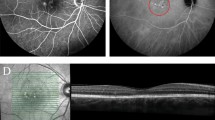Summary
The exudative stage of age-related macular degeneration (AMD) with choroidal neovascularization (CNV) commonly leads to rapidly progressive visual loss. Conventional laser coagulation with its unspecific destruction of the CNV, including adjacent retinal structures, often causes an additional reduction in visual acuity, particularly in cases with central localization of the pathological process. Photodynamic therapy (PDT) induces selective occlusion of CNV via light-induced pharmacological thrombosis without any damage to the retina in the macular area. Pilot studies have demonstrated complete occlusion of CNV with subsequent restoration of retinal function. Even repeated application was not associated with any alteration of the photoreceptor layer. The treatment strategy in PDT consists of repetitive thrombosis of CNV with progressive occlusion of the exudative lesion adjusted to the angiographic appearance. A randomized multicenter trial is currently underway and is evaluating the long-term visual results documented in 609 patients with subfoveal CNV who underwent control and eventual PDT at 3-month intervals. If PDT proves to be beneficial, an easy and non-invasive treatment modality could be offerted to numerous patients who demonstrated occult classic CNV and are otherwise facing an extremely poor prognosis.
Zusammenfassung
Das exsudative Stadium der altersbezogenen Makuladegeneration (AMD) mit chorioidaler Neovaskularisation (CNV) führt zu einem rapide progredienten, irreversiblen Visusverlust. Die konventionelle Laserkoagulation mit unspezifischer Zerstörung der CNV einschließlich umgebender Netzhautstrukturen und einem weiteren Visusverlust ist gerade bei der häufig zentralen Lage der Gefäßproliferation nicht sinnvoll.
Die photodynamische Therapie (PDT) induziert einen selektiven Verschluß der CNV durch eine licht-induzierte pharmakologische Thrombose ohne Beeinträchtigung der Netzhaut im Makulabereich. In Pilotstudien konnte gezeigt werden, daß ein kompletter Verschluß der CNV mit nachfolgender Erholung der Netzhautfunktion erzielt werden kann. Auch wiederholte Anwendungen führen nicht zu einer Schädigung der Photorezeptoren. Die Behandlungsstrategie der PDT bei CNV besteht entsprechend in einer schonenden Thrombose der CNV angepaßt an den angiographischen Befund mit progredientem Verschluß der CNV.
Eine multi-zentrische, randomisierte Studie untersucht derzeit die Visusergebnisse bei 609 Patienten mit subfovealer CNV nach PDT in drei-monatigen Kontrollintervallen im Langzeitverlauf. Bei positivem Studienausgang stünde mit der PDT eine wenig aufwendige und schonende Behandlung einer großen Zahl von Patienten mit okkulter und klassischer CNV zur Verfügung, für die bisher keine therapeutische Perspektive besteht.
Similar content being viewed by others
Author information
Authors and Affiliations
Rights and permissions
About this article
Cite this article
Schmidt-Erfurth, U. Photodynamic therapy. Minimally invasive treatment of choroidal neovascularization. Ophthalmologe 95, 725–731 (1998). https://doi.org/10.1007/s003470050343
Published:
Issue Date:
DOI: https://doi.org/10.1007/s003470050343




